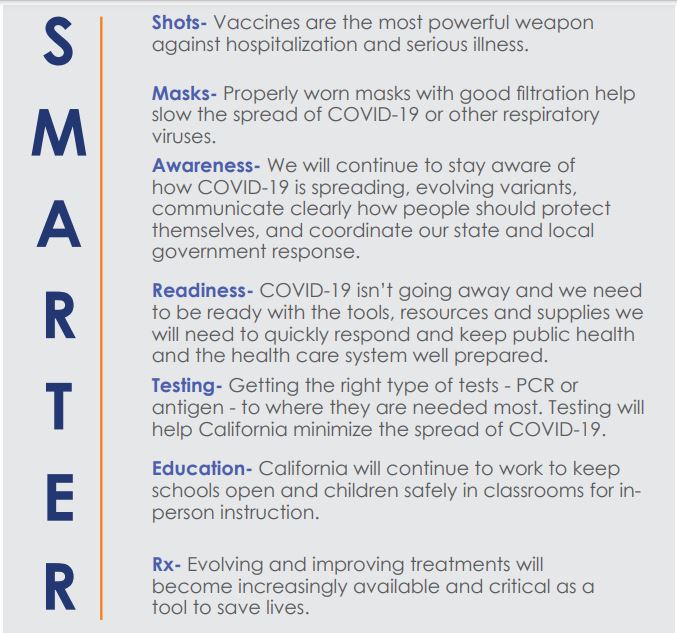Building on lessons learned over the past two years and the state’s commitment to equity, the SMARTER Plan focuses on continued readiness, awareness and flexibility to guide California’s pandemic response.
California has implemented the most robust vaccination and testing programs in the country, maintaining one of the lowest death rates among large states.
Governor Gavin Newsom announced on February 17 “California’s SMARTER Plan” as the next phase of our COVID-19 response. “As cases decline, we’re moving forward – preparing for the future based on what works.”
It will guide how we move ahead and be prepared for whatever COVID-19 brings, while building on lessons from the last two years.
“As we enter the next phase of the pandemic, the state is better equipped than ever to protect Californians from COVID-19 with smart strategies that save lives and advance our ongoing recovery,” said Governor Newsom, who outlined the plan last Thursday. “Building on proven tools – rooted in science and data – that have been honed over the past two years, we’re keeping our guard up with a focus on continued readiness, awareness and flexibility to adapt to the evolving pandemic. As we have throughout the pandemic, the state will continue applying the lessons we’ve learned about the virus to keep California moving forward.”
The SMARTER Plan’s core pillars and preparedness metrics focus on lifesaving public health measures and strategies the state has successfully used to slow the spread and protect Californians. Recognizing that each variant brings with it unique characteristics relative to the specific conditions in our neighborhoods and communities, the Plan preserves needed flexibility and ensures the state has the resources and capabilities in place to tackle the COVID-19 challenges that lie ahead:
- Shots- Vaccines are the most powerful weapon against hospitalization and serious illness. Under the Plan, California will maintain capacity to administer at least 200,000 vaccines per day on top of existing pharmacy and provider infrastructure.
- Masks- Properly worn masks with good filtration help slow the spread of COVID-19 or other respiratory viruses. The state will maintain a stockpile of 75 million high quality masks and the capability to distribute them as needed.
- Awareness- We will continue to stay aware of how COVID-19 is spreading and evolving variants, communicate clearly how people should protect themselves, and coordinate our state and local government response. California will maintain capability to promote vaccination, masking and other mitigation measures in all 58 counties and support engagement with at least 150 community-based organizations.
- Readiness- COVID-19 isn’t going away and we need to be ready with the tools, resources and supplies that will allow us to quickly respond to protect public health and to keep the health care system well prepared. The state will maintain wastewater surveillance in all regions and enhance respiratory surveillance in the health care system while continuing to sequence at least 10 percent of positive COVID-19 test specimens. The state will also maintain the ability to add 3,000 clinical staff within 2-3 weeks of need and across various health care facility types.
- Testing- Getting the right type of tests – PCR or antigen – to where they are needed most. Testing will help California minimize the spread of COVID-19. California will maintain commercial and local public health capacity statewide to perform at least 500,000 tests per day – a combination of PCR and antigen.
- Education- California will continue to work to keep schools open and children safely in classrooms for in-person instruction. The state will expand by 25 percent school-based vaccination sites supported by the state to increase vaccination rates as eligibility expands.
- Rx- Evolving and improving treatments will become increasingly available and critical as a tool to save lives. The state will maximize orders for the most clinically effective therapeutic available through federal partnerships, ensuring allocations of effective therapeutics are ordered within 48-hours.
Dr. George Rutherford, UCSF, agreed, “SMARTER is just that. It’s a plan to take all that we’ve learned from the first two years of the COVID-19 pandemic and use that knowledge to go forward. COVID-19 will be with us for several years to come, and having a nimble plan that can respond strategically to the twists and turns the pandemic will undoubtedly take will be invaluable for Californians.”
George W. Rutherford, MD, AM
Professor of Epidemiology, Preventive Medicine, Pediatrics and History
Head, Division of Infectious Disease and Global Epidemiology
Department of Epidemiology and Biostatistics School of Medicine
University of California, San Francisco





